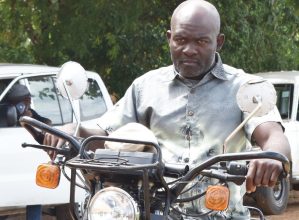When disaster strikes, who minds the disabled?

The first strike of the Karonga 2009 earthquake—which killed two, injured hundreds and destroyed many properties—shook the ground at exactly 21:45 hours.
Dazed men left their wives and children in their homes. Women, too, had little to mind about their children. In the chaos of continued strike of the quake and the dread of running to safety, everybody ran for dear life.
But what about the disabled? The visually impaired that could run, of course, yet not sure of where they were going? The hearing impaired that could feel the danger but could hardly make sense of it easily. The physically impaired—for instance those that do not walk—that could hardly flex their muscles and flee.
Mary Muyira of the flood-prone Tengani Village in Nsanje, recalls waking up in the dead of the night in January this year, awakened by the sounds of distant drums.
“The sound of that drum at that particular time signals danger here. As I struggled to wake up, I found my feet getting wet; water was all over the house,” she said.
With her husband having travelled far, Muyira grabbed her two children and struggled her way to safety. Unfortunately, in search for her safety and that of her children, Muyira forgot about her neighbours.
“I live close to a couple with visual impairment. They both cannot see and they do not have a child. I began to think about them after I had finally gone upland—to a primary school where most of the people converged.
“With a sense of shame and guilt, I quickly talked to some three boys to go and check for them,” Muyira says.
She adds that the boys told her that they found the couple almost submerged.
“They said they found them holding on tightly to each other while leaning on to the wall,” she says.
The boys dragged the couple to safety and when they joined the rest of the people upland, Muyira shed tears of joy.
It is situations like these that moved the United Nations to theme this year’s International Day of Disasters, which falls on October 12, as ‘Living with Disability and Disasters’.
Stern Kita, principal mitigation officer in the Department of Disaster Management, says people with disabilities do not just suffer neglect when disasters strike.
“They also, despite their enormous skills, do not participate in formulating strategies of containing disaster risks,” he says.
There are a number of areas where people with disabilities are not involved in disaster management despite, sometimes, bearing the worst of consequences.
According to news reports, when an earthquake struck California, US in 1994, a man was turned away from a shelter because the staff could not understand sign language. People with cerebral palsy were ignored because shelter volunteers thought they were on drugs, according to Handicap International.
It was also reported that after the 2004 Indian Ocean tsunami, there were many examples of persons with disabilities being unable to escape the waves and drowning.
In Sambodhi Residential Home in Galle, Sri Lanka, only 41 of its 102 residents survived; many of those who died were unable to leave their beds or failed to comprehend in time the need to escape.
In fact, even the Hyogo Framework for Action (HFA)—the global disaster risk reduction plan that was adopted in 2005 for 10 years (to 2015) to build the resilience of nations and communities to disasters—barely details the struggle of those with disability.
The HFA—which is the first document to explain, describe and detail an all-of-society approach to reduce disaster losses and impacts—does not make a direct reference to persons living with disabilities, although it spells out the need to take account of cultural diversities, age, and other causes of vulnerability when planning for disaster risk reduction.
A survey last year in Fiji of disability inclusiveness in disaster preparedness and risk reduction found that persons living with disabilities are not considered in disaster evacuation processes.
The Pacific Disability Forum programme manager Katabw
In fact, even in Malawi’s national disaster management and risk reduction plans, there is very little reference to disability issues.
This years’ International Day for Disaster Reduction, says Kita, is an opportunity for persons living with disabilities to be included and express themselves in the consultations on the post-2015 HFA framework that began in March 2012.
“The goal is a successor to the HFA, which is the product of the broadest possible consultations. Everyone who joins the conversation can help change the current status quo, and influence the next generation Hyogo Framework for Action, so it will take into account the needs of persons living with disabilities in potential disaster scenarios,” he says.
As part of the commemoration, Kita says the national event will be held on October 17 at Kachulu Police Unit Ground, approximately 35 kilometresfrom Zomba City.
Before the day, there will be a panel discussion at Chancellor College.





